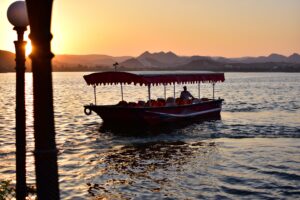
Welcome to Rajasthan, a state in India known for its rich history, vibrant culture, and stunning architecture. In this guide, we will explore the top 10 Famous Forts in Rajasthan that showcase the grandeur and opulence of the Rajput era. Each fort, from the majestic Mehrangarh Fort in Jodhpur to the stunning Amber Fort in Jaipur, has a unique story to tell. But before that, let us take a journey into the history of Rajasthan and try to assess what these forts are truly symbolizing in terms of power, resilience, and architectural brilliance. Join us as Salam Travellers take you to the fascinating world of Rajasthan’s forts and discover the legacy of the Land of Kings.
Rajasthan: A Land Steeped in History
Rajasthan is located in northern India, covering 10.4% of the geographical area of the state. The border lines of this capital touch the Pakistan border, and this city has the 7th rank in India by its population as well as being the largest city in India due to its area. Thar Desert is the city’s largest desert.
The old name of Rajasthan was Rajputana, which means ruled by Rajputs. Rajput kings ruled this, so they built their hill forts and palaces here, which the Rajasthani government still maintains.
Also read: 6 Must-See Cultural Attractions in India That Will Leave You Awestruck
This city is famous for tourists. Forts and palaces, temples, lakes, and deserts are integral points of attraction to visit. Visitors come from across the world to visit these points and learn about the history of these buildings. Here, the Forts of Rajasthan have tremendous importance in the heritage and culture, as they depict the architectural style of an old era.
The Allure of Forts
Among these forts, Amer Fort, Mehrangarh Fort, Jaisalmer Fort, Ranthambore Fort, Chittorgarh Fort, Kumbhalgarh Fort, Junagadh Fort, Taragarh Fort, and Galore Fort are the most up-listed forts in Rajasthan, and here we will mention the details related to these points one by one.
These complex forts are famous for their magnificent heritage and hidden tunnels. Most of these forts were constructed between 1300 AD and 1500 AD. These were designed to show wealth and for defense purposes, which show the glory of the kings of that time. Let’s learn more about the top 10 most famous forts in Rajasthan.
Also read: A Guide to Ananta Spa and Resort Ajmer
The Top 10 Most Famous Forts in Rajasthan
1. Amer Fort
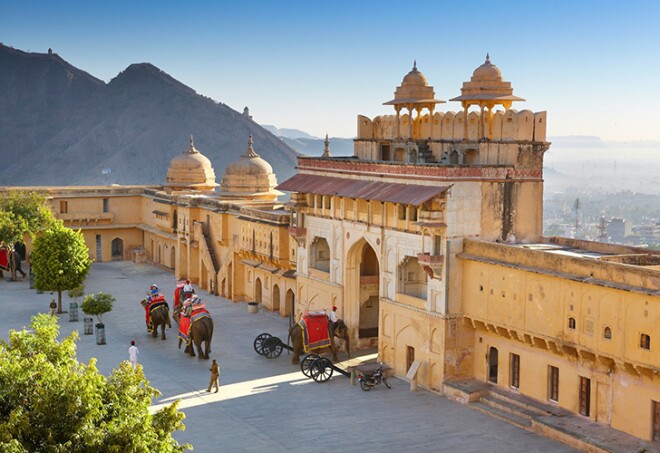
Amer Fort is situated in Amer, a 4 sq. km. town in Rajasthan. This fort is well known for its hilltop architectural style. The fort was built in 1592 under the reign of Raja Man Singh and depicts the Mughal architectural style.
The fort overlooks Malta Lake, which was a source of water supply for the fort; marble and red sandstones are used in constructing the fort walls to make them solid and thick. As this fort was built to protect Amer from its enemies, underground hidden tunnels were also developed, which connected Amer Fort with Jaigarh Fortis and are now open for public visit.
The model of the fort stands on 40 pillars, which make it distinct from other forts. Diwan-e-Aam, Diwan-e-Khas, Seesh Mahal, and elephant rides are primary sources of enjoyment for visitors.
The garden in the fort is designed with a hexagonal structure and depicts Persian and Mughal style geometric patterns. The park was created in Maota Lake to admire the harem ladies above all.
The elephant ride in the fort starts from the parking area and ends in the courtyard, which takes 10 to 20 minutes for a total ride. It is a joyful experience, and have fun with it. A light and sound show also becomes the mode of enjoyment for tourists, which starts in the evening.
As Rajasthan has high temperatures, it is best to visit these areas during the winter season. The light and sound show begins in the evening and lasts 52 minutes from October to February. It starts at 7:30 p.m. Still, from March to April, it continues from 7 p.m. to 8 p.m.; the tickets for this show are also affordable, at INR 295, including GST. Still, children under seven years old are free to enter, so you should visit the Fort in the evening, and a guide must accompany you to guide and explore the Fort effectively.
- Timing: 8:00 a.m.–6:00 p.m. (every day)
- Entry Fee: INR 25 per person for Indians and INR 200 per person for foreign tourists.
2. Mehrangarh Fort

Mehrangarh Fort is located in Jodhpur, Rajasthan, and is stretched around 1200 acres as a hilltop fort. This fort was built in the 17th century, in 1459, by ruler Rao Jodha.
The majestic beauty of the Fort is revealed in its architectural style, which has a history of 550 years because rulers have altered it over time according to the construction techniques of their respective times.
The walls of this fort are massively thick and high, as the width of the walls is 69 and the height is 118 feet. The Fort has seven gates, one of them named Jai Pol, which Raja Man Singh constructed to commemorate his victories in Jaipur City and Bikaner’s army in 1806. Moti Mahal, Pool Mahal, Sheesh Mahal, Sileh Khana, and Adulation Khana are some of the palaces that were built in Fort
Jodhpur Umaid Bhawan Palace is not just a building to visit; many activities are there to engage you. A museum is established in Fort, which carries t-shirts, jewelry, bags, caps, books, perfumes, and many other handcrafted things that you can buy directly from the museum or book online.
Regional artists perform folk music and dance at the front entry door. From the top of the fort, you can enjoy splendid scenery and exotic views of Jaipur and Pakistan. Chamunda Mataji temple is also in Fort, which tourists visit.
Zip line adventure is also a source of attraction because 300 meters of zip line of different heights and lengths stretch in Fort and are charged INR 1650 for adults and INR 1450 for children to experience this thrilling activity. This adventure is available from 9 a.m. to 5 p.m., but the morning hours are best to experience the beauty of Rajasthan.
- Timing: 9:00 a.m.–5:00 p.m. (every day)
- Entry Fee: INR 60 per person for Indians and INR 400 per person for foreign tourists.
3. Jaisalmer Fort
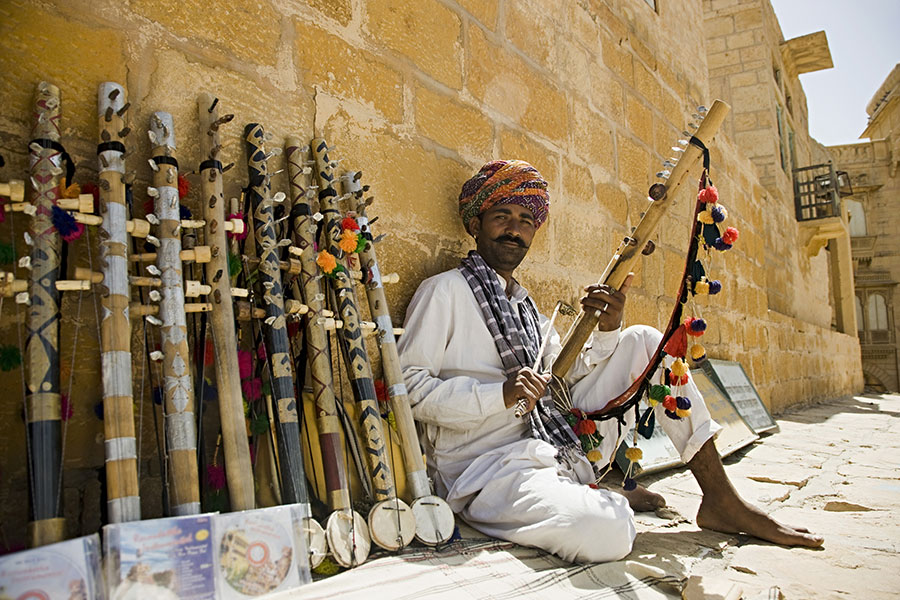
Jaisalmer Fort is the second oldest fort in Rajasthan, situated in Jaisalmer city. The city is also called the Golden City of India due to the yellow sandstones used in constructing the fort and some in town. These stones shine in the sunlight and present the fascinating beauty of Jaisalmer. The fort was built in 1156 AD by Rawal Jaisal at a height of 250 ft. from the countryside.
The fort has four gates, which are used by tourists, and 7 Jain temples in it. Numerous merchant havelis were also constructed in the fort by wealthy merchants. Some of these were later converted into old museums, but a few are still maintained and lived in by the people who built them.
Jaisalmer Fort has INR 50 for entry for Indians, but foreigners have to pay INR 250 per person to enter the fort. Camel safari is an adventurous activity for visitors who visit the Fort, as this Fort is situated in the Thar Desert, so camel rides are available in the dunes of the Desert.
You can take advantage of this opportunity from 4:30 a.m. to 6 p.m., then again in the evening from 4 p.m. to 6 p.m. The owners charge INR 500 per person for a camel ride. During the day, the temperature of the desert increases, so visitors have to wear full sleeves to prevent sunburn, and you should also wear sports shoes.
But at night, the temperature falls, so you have to take a moderate shawl or jacket with you. You can also try camping in the dunes or staying at the nearest accommodation at Jaisalmer Fort.
- Timing: 9:00 a.m.–6:00 p.m. (every day)
- Entry Fee: INR 50 per person for Indians and INR 250 per person for foreign tourists.
4. Ranthambore Fort
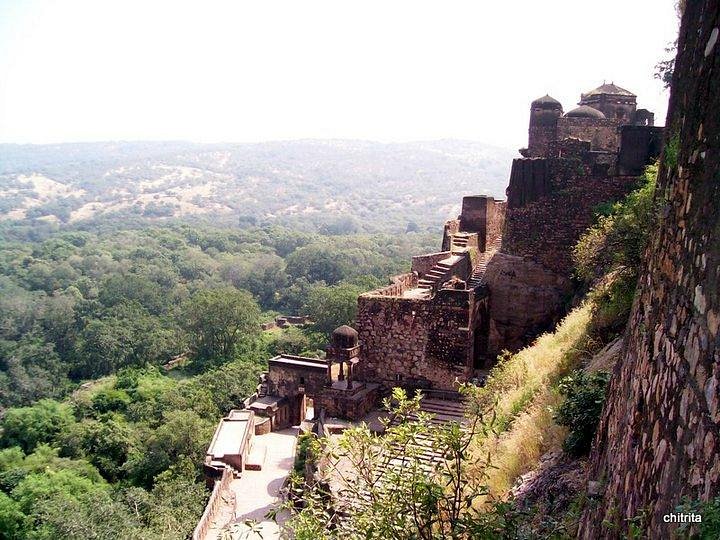
Ranthambore Fort is situated in Ranthambore National Park in Sawai Madhopur, a district of Rajasthan. Ranthambore is known for being the land of tigers. The Fort was constructed in 944 AD at the top of two mountains, which join together at a point. Thus, the fort is also famous for hill forts, as it is 481 ft. above sea level.
This fort is surrounded by dense forest and stretches about 4 miles. As with time, many of its constructions were ruined, but still, it shows the glory of its time. In Fort, there are palaces, cenotaphs, tanks, and temples.
By parking your car in a parking area, you have to walk 200 steps to reach the top of the fort, from where the park’s beauty can be enjoyed.
Ganesh Temple, Badal Mahal, and Hammirs Court are the objects of attraction for tourists. Ganesh temple is designed in the Fort, where people write letters to Ganesh, which are posted daily by local postmen.
The Fort has seven gates for entry and a badal mahal called the Palace of Clouds; though it is a ruin today, its beauty can be felt by its walls, which stand in full glory. The Fort is lying in Ranthambore National Park, so history enthusiasts visit the Fort as nature lovers also come to view the park’s beauty. Wildlife can also be observed in the forests surrounding the fort.
The voices of eagles and other wild animals can be heard on top of the fort. It would be best to visit the Fort from October to March, as it is best to see these areas during this season. The Fort has no entry fee and opens from 6 a.m. to 6 p.m., so visitors must visit during the park’s opening hours from July to September.
The park is closed, so only the Fort can be called Madhopur, which has no airport but is connected to Jaipur’s bus network. Book an online Ranthambore jungle safari controlled by the government. The ride will pick you up and drop you off at your hotel. As well, you can also book your desired hotel by making an online booking.
- Timing: 6:00 a.m.–6:00 p.m. (every day)
- Entry Fee: INR 15 per person for Indian adults and INR 10 per person for Indian children.
5. Chittorgarh Fort

Chittorgarh Fort is located on the 180-meter-high hill of Chittorgarh, the capital of Mewar, Rajasthan. This fort is the largest in India and Asia. Numerous monuments and towers were built by rulers in this fort, such as Vijay Stambh, Kriti Stambh, Rana Kumbha Palace, Padmini Palace, and Meera Temple, which are historic buildings that have become the center points of attention for tourists.
The Fort is not a leisure hub, but you can buy many precious things like camel leather jutis, Thewa jewelry, and wooden painted toys inside the Fort. This fort opens for tourists from 9:30 a.m. to 5 p.m.
Vijay Stambh is one of the towers of the Fort, which means the Tower of Victory. This tower was established to celebrate the victory of kings against their enemies at that time. This nine-story tower has many sculptures and carvings on the outside walls, and you have to cross 157 steps to reach the top of the tower.
Many paintings of weapons and gods are kept inside the tower. Kriti Stambh symbolically evokes the Tower of Fame. Rana Kumbha Palace was built near Vijay Stambh. This palace is famous for being the birthplace of Maharana Udai Singh.
Padmini Palace is renowned due to its story, according to which Alau Khilji, ruler of the palace, set a mirror in his palace in such a direction that he could see Padmini Princess. The fort management charged INR 25 for children and INR 50 for adults from India. You can visit this fort in Mewar by going to the nearest railway station in Chanderiyon.
6. Kumbhalgarh Fort

Kumbhalgarh Fort, another example of ancient history, is located in Aravalli Hills, Udaipur, Rajasthan. The outside wall of this fort is the Great Wall of India, which is 84 meters high and 36 kilometers long.
There are approximately 70 temples inside the fort that are relevant to Jains and Hindus. Shiva Temple is the most visited temple in this fort. When you enter Rampole Fort, you can observe a 500-year-old ancient Shiva temple. This temple indicates the old Indian architectural heritage in style. As forests surround the Fort, you can enjoy the greenery and beauty of nature from the top of the Fort.
Also read: Which is a better tourist place – Udaipur or Jaisalmer?
The fort is famous for being the birthplace of the legendary Indian king, Maharana Pratap. Outside the temple, a light and sound show is presented in the evening, so you should visit this place to enjoy its beauty.
The Fort is open from 9 a.m. to 6 p.m., so this duration is hectic for tourists. Like other forts, this should also be visited in the winter season so you can enjoy the relaxed and pleasant weather of this place.
7. Junagadh Fort

Junagadh is an excellent tourist attraction in Bikaner, Rajasthan. Karen Chand, the prime minister of Raja Rai Sing, inaugurated the construction of this fort. Like other forts in Rajasthan, this one is not built on a hilltop. This building is the finest example of Rajput architecture blended with Gujarati and Mughal architectural styles. This fort was constructed with red stones, which were brought from Jodhpur.
Anup Mahal, Mahal Parchina, and the audio guide facility are the sources of attraction for visitors to the location. The Anup Mahal served as the kingdom’s administrative headquarters. Italian tiles are engraved on the walls of the Mahal, and art of different eras is painted on windows to make it distinct from other buildings.
Later on, the extension of Anup Mahal was planned, and this extension was named Badal Mahal. Wooden swords, saws, and paintings were kept in this Mahal, which depicted the lives of the kings and queens of Fort.
The opening hours of this fort are 10 a.m. to 4:30 p.m., and local guides are available on entry at very reasonable prices, so non-Indians must hire them so that they can guide them about the fort explicitly.
8. Jaigarh Fort

Jaigarh Fort is placed on a top hill named Cheel ka Teela in the Aravalli range. This fort is 500 feet above sea level and was built by Sawai Jai Singh in 1725. The Fort was developed to protect the Amer Fort of Amer in Jaipur and overlooks Amer Fort and Maota Lake.
The Fort is also known as Victory, and the same material used in Amer Fort is used here: red sandstones. This tourism point is mainly known for featuring the world’s largest cannon. Jaivana cannon is placed at the Dungar gate of the palace.
At the left of Awami Gate lies the Museum of Fort, which showcases photographs of Jaipur’s royalty, spittoons, stamps, and hand-drawn architectural designs of the palace by artists of that time.
Water reservoirs are also a main attraction in Fort, which depicts the water reservation technology of the kings and the maximum utilization of these resources. Three water tanks were installed in Fort, connected with different lakes and canals on the hills. Every drop of this stored water was valuable and helpful in times of war or drought.
This fort is open to visitors from 9 a.m. to 5 p.m., with entry fees of INR 150 for Indians and INR 200 for foreigners. Students can get discounts by showing their ID cards. Due to its curving paths, a bus will drop you 5km away from the Fort, and you have to reach it on your feet, so the best way to access the Fort is by hiring a cab, taxi, or auto.
9. Taragarh Fort
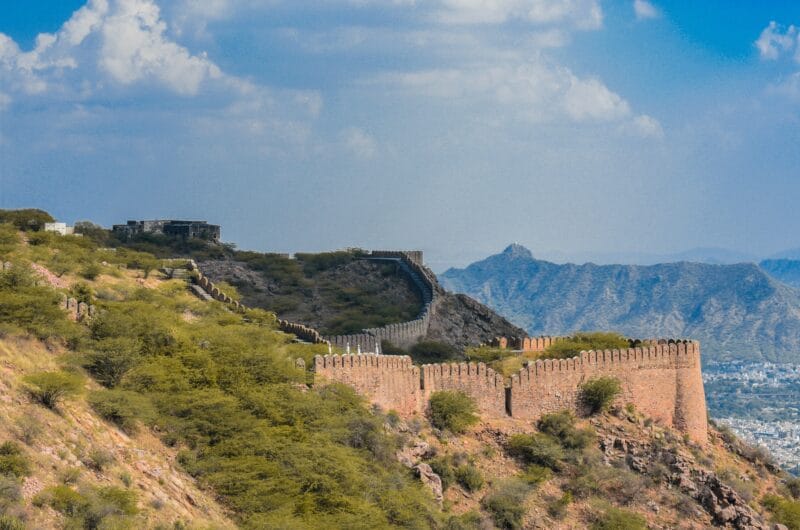
Taragarh Fort was established in Ajmer, Rajasthan. The fort is perched on the steep hillside of Ajmer and was built by Ajay Pal Chauhan in the 11th century. This appealing visit point is impressive in its architectural heritage and depicts the Rajasthani style of architecture.
Also read: Ajmer Sharif Dargah Tour – A Journey to the Heart of Sufism
The Fort is famous for its spectacular tunnels, designed to hide out for escape from invasion by foreigners and Turkish. Three gateways are built to connect the fort. The fort was used as a military center during the rule of the Mughals to run their army smoothly.
Bheem Burj, Garbha Gunjan, and Rani Mahal are the attractions of this fort. Rani Mahal is a fine piece of art and history. The view of the sunset will mesmerize you from this Mahal. Garbha Gunjan and Bhim Burj are stone towers in the fort, and Garbha Gunjan is the most extensive canon on the wheel under the Bhim Burj tower.
This cannon is the second-largest cannon in India. You can access Fort from 8 a.m. to 7 p.m.; any INR 25 will be charged as an entry fee. A guide can help you explore the fascinating beauty of Fort, and the points worth visiting can be seen under guide instructions more effectively. Amigo Mango Garden Restaurant and Desert Rose Cafe are the nearest restaurants to Fort.
10. Jalore Fort

Jalore is a small town in the state of Rajasthan, and the main attraction is Jalore Fort, an exquisite example of ancient architecture. This fort was built between 8 and 10 centuries ago. The fort is well known for its massive gates and bastions.
Four main gates are set to enter the fort: Dhruv pol, Suraj pol, Siron pol, and Bal pol. Suraj pol is also known as sun pol because this pol is designed in such a pattern that sun rays can penetrate fully into Fort. A watch tower is also built on top of this pole.
Jain temples, mosques, and top khanas are the charming places to visit in this fort. The Fort has numerous Jain temples on its premises, one of which is a temple with a shrine to Lord Adinath.
This temple is worth visiting due to its beauty, enhanced by the white marble on its floor. The mosque is also pretty and reflects the Gujarati style of architecture. This mosque is well known as the Kila mosque. Raja Bhoj, a ruler of that time, developed a Sanskrit school inside the Fort, but in the author’s era of rule, this was converted into Thopkhana, which means chamber of cannons.
The beauty of this place is hidden in the inscriptions of geographical patterns on the mosque and temple walls. This chamber was used to store weapons, swords, and other weapons. This fort has no entry fee and is open from 5 a.m. to 12 p.m. 2 hours are enough to visit this place, and you can reach here by road or by train. Bhimal railway station is the nearest station to reach this fort.
Final Analysis
This guide provides detailed information related to the top 10 most famous forts in Rajasthan. This article provides brief information regarding entry fees, activities, and attractions found in these forts. As Rajasthan is famous for its vibrant culture and historical architecture, you should visit this city to learn about your forefathers’ glory, victories, and culture.
This visit will also be helpful to learn about the luxurious living styles of Rajput kings. Cultural diversity and magical scenery will encourage you to explore more about Indian culture, and the trip will give you a relaxing feeling after a hectic routine. As Rajasthan is a heated area, you should visit in the winter season, as the temperature will fall to moderate sunshine if you come in the summer, so you should have a sunscreen cap to avoid heat. To prevent hydration, a water bottle should also be kept in your bags, and clothes should follow the weather in the area.

